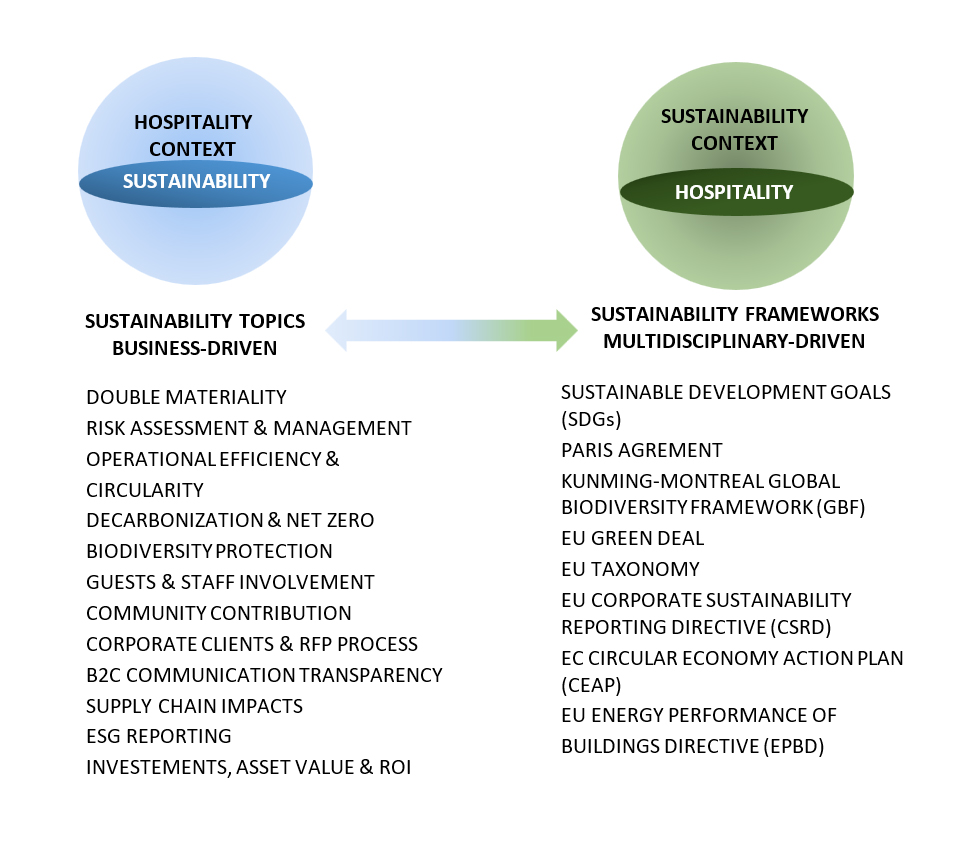ESG and Hospitality: An Evolving Sustainability Context


Synopsis
This article discusses the importance of understanding the relationship between sustainability and hospitality in the current global context, which is characterized by a convergence of global risks linked to climate change and biodiversity collapse. The hospitality industry operates in a volatile, uncertain, complex and ambiguous environment, which makes it difficult to devise a resilient path that considers environmental, social and governance risks. In his article, Professor Willy Legrand argues that it is crucial for business leaders to understand both sides of sustainability and hospitality and build connections between them. This means considering global goals and initiatives, as well as national and supranational guidelines and legislations that affect a business's ESG reporting strategy. By taking a holistic approach, the hospitality industry has the opportunity to advance sustainability overall.
French poet Paul Valery once stated that ‘everything simple is false, everything complex is unusable’[1].
Today’s global context is anything but simple. We are exposed to a convergence of global risks linked to climate change and biodiversity collapse posing a threat to the fabric of society. We are also faced with turbulent socio-economic situations and unstable geopolitics. The convergence of global systemic risks is coined as the ‘global polycrisis’[2]. The hospitality industry operates in a volatile, uncertain, complex, and ambiguous environment. Since complex is unusable, and knowing that hospitality performs best under stable conditions[3], what is the best strategy to devise today to lay the foundation to a resilient path considering the Environmental, Social, and Governance (ESG) risks?
Evolving Sustainability and Hospitality Contexts
If you were to look at your hotel from above, say on a hot air balloon ride, you would be able to point out the many hospitality and building-features down below. The shape of the building as well as the surrounding lawns, flowerbeds and trees. You would be pointing out the roofing and photovoltaic panels. You could see the waiters busy serving food and drinks on the front terrace and guests lounging or casually strolling around the hotel building.
If you were to slowly rise up with the air balloon, high enough to see the earth’ curvature, the view of the hotel building becomes blurred. You see farms cultivating crops, the infrastructure of roads and train tracks transporting goods and passengers, a coal power plant powering a city, a quarry and a forest providing key resources and so on. Rising up further, the earth’s meandering streams, rivers, estuaries and vast oceans become the focal point, along with mountains and meadows and climatic conditions or rain, sun, clouds and storms.
When discussing sustainability, a similar scenario occurs as shown in Figure 1. On the right-hand side, sustainability is the context within which hospitality operates. This is represented by a series of global goals and various national and supranational initiatives, guidelines and legislations to which everyone, including the hospitality sector, is bound.
These are the results of global societal demands and expectations, as well as extensive scientific research on the state of the environment. On the left-hand side, hospitality is the context and sustainability a component of the many business strategic and operational decisions. Under the umbrella of the global tourism industry, the ultimate goal is the advancement of hospitality via hotel development, hotel refurbishment and hotel operations. We argue that it is crucial for business leaders to understand the implications of both sides and build the connections. This means taking a hot air balloon ride just above the hotel and slowly rising up. For example, the European Union Corporate Sustainability Reporting Directive[4] and the corresponding European Sustainability Reporting Standards[5] affect a business’ ESG reporting strategy. The Kunming-Montreal Global Biodiversity Framework (GBF) [6] laying out concrete measures to halt and reverse damage to the natural environment may guide your hotel biodiversity and environmental protection plans. Building connections between the right- and left-hand side presents immense opportunities to advance sustainability overall.

Source: Adapted from Fletcher and Dewberry, 2002[7] & Boley, 2011[8]
Two Sides of the Same Coin
The hospitality industry’s dependency on stable climate and healthy ecosystem services means that any disruption in those natural cycles can have significant impacts on the financial, reputational and legal performance of a business [9]. Conversely, the hospitality sector affects its environmental and social surroundings through operations, products or services. Hospitality companies leading the sustainability conversation are those that 1) understand the double materiality of their business, 2) have identified the related risks and 3) have assessed opportunities with a clear focus on tangible impacts.
However, there is a tendency to see and deal with problems or challenges in silos: Focus on one problem, fix it and move on - and this is particular to sustainability with an acute carbon tunnel vision. In other words, all eyes are on the carbon ball, but biodiversity loss, water crisis, inequality, health and education, resource shortages and overconsumption are all part of a sustainability transition.
The argument is that climate change and biodiversity loss are two sides of the same coin and should be tackled accordingly [10, 11]. Similarly, environmental sustainability and social justice are interlinked. Environmental sustainability aims to protect, preserve and restore the natural resources and ecosystems that support life on Earth. Social justice aims to create a fair and equitable society by addressing issues such as poverty, inequality, and discrimination. Both environmental sustainability and social justice must be integrated and prioritized in decision-making and actions to shape a desirable future for all.
Materiality Assessment as a Guiding Tool
For hospitality business leaders still wondering what to do today or where to start on the environmental and social sustainability path, undertaking a materiality assessment would make sense to pave the way. Through a materiality assessment, a business can identify and prioritize the ESG issues that are most relevant and impactful to 1) the operations, economic stability and reputation as well as 2) the stakeholders including customers, employees, investors, suppliers, and local communities. The purpose of this exercise is to inform and guide the development of a company's sustainability strategy, programs, and actions while ensuring transparency and accountability to the stakeholders.
A materiality assessment typically involves the following four steps:
Step 1: Stakeholder engagement: The first step is to engage with stakeholders, such as customers, employees, investors, suppliers, and local communities. The purpose is to gather information, perspectives and opinions on the ESG issues that are most important to them.
Step 2: Issue identification: The second step is to identify the ESG issues that are most relevant and impactful to the business and its stakeholders, based on stakeholder engagement and other relevant data and information.
Step 3: Assessment of materiality: The third step is to assess the materiality of the identified issues. Those issues are evaluated in terms of their level of significance and impact on the stakeholders and on the business's operations, finances, and reputation. This step often includes the creation of a materiality matrix, which is a visual representation of the identified ESG issues.
Those ESG issues are placed on a scatter chart with one axis depicting the impact intensity on the business (from low to high, or minor to strategic for example) and the other axis showing the impact intensity on the stakeholders.
Step 4: Prioritization: The final step is to prioritize the material ESG issues based on the results of the materiality assessment. The highest ranked issues in the materiality matrix are considered the most critical and impactful and should be integrated and prioritized during the development of the company's ESG strategy, programs and actions.
A materiality assessment helps hospitality business leaders to answer the following five questions related to sustainability within a business-context, always keeping in mind the evolving sustainability-context (see Figure 1):
- what issues matter to my business?
- what issues matter to my stakeholders?
- what and who do I impact with my operations?
- what are my biases, what are my risks and ESG dead angles?
- how can I prioritize my actions with the greatest impacts?
Simplifying ESG Reality without Betraying the Complexit
Global environmental phenomena are complicated and interdependent but increasingly well-researched [12]. And ‘in business, complexity gets bad press’ [13]. Hospitality operations and business development amidst unstable environmental and social structures is extremely complex. Shifting from the ‘what’ of ESG to ‘how fast can the industry adopt new models to mitigate and cope with increased uncertainty’ is the name of the game.
Hospitality business leaders and all those dedicated to advancing ESG-matters are encouraged to analyze, structure, express and formulate simple and actionable answers to complex ESG challenges, without betraying the inherent complexity. It is said that ‘every journey starts with the first step’- in 2023, take that first step.